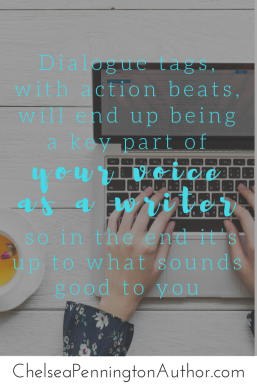We have conversations of all sorts every day, and yet including them in our writing can be challenging. What’s interesting to the reader? What is too boring or too confusing? One of the key parts of writing when characters are talking is dialogue tags, and they can make or break your conversation.
So what are dialogue tags? They’re pretty simple: it’s what tells you who is talking. They’re the ‘he said’ or ‘she whispered’ or ‘Jill yelled’ after a direct quotation in writing. They can also be called dialogue attribution, since it tells you to whom the dialogue is attributed. Believe it or not, these little words can be a source of big debate in the writing world, and they hold a lot of power when it comes to writing dialogue. But this means if you master them, your dialogue will only improve. Below are a few tips on using dialogue tags.
When in doubt, use ‘said.’
Take a look at the following conversation:
“What do you think you’re doing?” he exclaimed.
“I’m taking what’s rightfully mine!” she hissed.
“But I won it fair and square!” he shouted back.
“Too bad!” she declared.
“You’re a monster!” he cried.
What do you notice? Did you say that it seems a little repetitive, but also somehow over-the-top? It’s because of the dialogue tags. Using “fancy” dialogue tags like exclaimed, hissed, shouted, declared, or cried are okay, but only every now and then. Instead, stick with using “said.” It’s like a little invisible word. The reader will note the name or pronoun of whomever is talking, but it won’t bog them down as they read the conversation. “Asked” is the same way when the person is using a question. Both of these words are used so much in writing that readers can skim through them, in a good way.

Of course, sometimes those fancy dialogue tags are helpful. The more you read and write, the better you’ll get at deciding when you should use another word in place of said. Before you use a fancy dialogue tag, ask yourself if there is another way to express that emotion while still using “said.” This goes along with that classic writing advice “show don’t tell.” Instead of telling us “he declared,” try showing us his confidence or forcefulness through his actions. This brings us to…
Action beats are your friend.
Actions beats are the little descriptions of actions in between dialogue. Consider the earlier conversation, but now using action beats.
“What are you doing?” He stared at her, mouth open.
She picked up the crown. “I’m taking what’s rightfully mine!” She held the crown aloft, letting the jewels sparkle in the flickering light.
“But I won it fair and square!” He lunged for her, swiping at the crown, but she spun out of the way.
“Too bad!” She ran to the window, stuffing the crown in her bag and getting ready to climb out.
“You’re a monster!” he called after her, but she had already disappeared into the night.
Okay, still not the best (consider it a first draft) but it’s already loads better than the first rendition. Exact same words, but instead of having the repetitive structure of the dialogue tags combined with the over-the-top nature of the word choice, we get a much better idea of what’s going on in the scene while still knowing who’s talking and how they feel, all while keeping the reader far more engaged.
Notice I still use one “fancy” dialogue tag (“he called after her”), but it’s been balanced by replacing all the other dialogue tags with action beats. In most scenarios, you can paint a far clearer (and more interesting) picture by using action beats rather than dialogue tags. Again, the more you write and read, the better your sense of when to use dialogue tags vs. action beats will be.
Sometimes, less is more
There are also conversations where not having dialogue tags or action beats may be the best choice. In a scene with more tension and action like the example above, this probably wouldn’t be a good strategy. But in a short, more casual conversation between two characters, it can work well.
“Are you going to the store?” she asked.
“Yep.”
“Will you grab some milk?”
“Was already planning on it.”
Okay, not the most riveting conversation, but you can see how limiting it to just the dialogue keeps the pacing up and keeps the story moving forward without bogging the reader down in a lot of details. Use this style sparingly, as more often than not, it’s better to have description, but there are instances where you’re better doing without.

Remember how I mentioned earlier that dialogue tags were the cause of heated debate in the writing world? That’s because, ultimately, it’s up to your taste as an author. Some writers say absolutely only use said. Some say that’s horrible advice and prefer to use lots of fancy dialogue tags. Yet others say only use action beats. Dialogue tags, with action beats, will end up being a key part of your voice as a writer, so in the end it’s up to what sounds good to you (and, let’s be honest, what your beta readers think). So keep reading and writing, and trust your author’s gut.

If you liked this article, pin it to share and save it for later.
What do you think about dialogue tags? How do you use them in your writing? Let me know in the comments!
You may also like . . .
Cover photo by Kenan Buhic




One thought on “Dialogue Tags: what they are and how to use them”